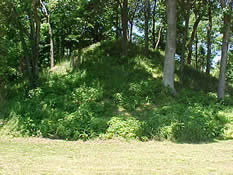Eli Lilly was born to Josiah K. Lilly and Lilly
Ridgely on April 1, 1885, in Indianapolis.
He was the grandson of Colonel Eli Lilly, founder of the Indianapolis-based
pharmaceutical company that still bears his name today. From
his grandfather and his cabin on the shore of Lake
Wawasee, Lilly gained an interest in Native Americans
and folklore. Lilly spent many summers at the cabin on the
lake during his youth and even after he was married.
One of the defining moments in Lilly’s
later years was in mid-December, 1929. He was writing to his
only daughter, Evie, and told her that this year they would
do something special on their trip to Lake
Wawasee. He mentioned that he had been studying the history
around the lake and that they were searching for Indian burial
mounds. Although they failed to find any Indian mounds, the
45-year-old businessman found a new love: archaeology.
Lilly soon began to collect Indian artifacts,
purchasing pieces from various collectors and dealers. Over
the next several years, he amassed a collection of artifacts
totaling over $20,000. The collection slowly came to a stop,
though, as Lilly’s attitude changed from that of a dilettante
collector to a professional student of archaeology. Through
examining his own collection, he found material to write his
first book, Prehistoric Antiquities of Indiana. It
was published through the Indiana
Historical Society, of which Lilly became a very influential
and prominent member.
 |
A
mound at Angel Mounds
State Historic Site |
In Prehistoric
Antiquities of Indiana, Lilly discusses a variety
of topics revolving around Native American life in Indiana.
He lists three main patterns categorizing known mound and
village sites in the Ohio Valley: “The Woodland,”
“The Mississippi,” and possibly “The Hopewellian"
phase.
With a basic knowledge of these
patterns, Lilly describes many artifacts, some of which were
excavated from mound sites around Indiana. The artifacts range
from arrowheads to pottery to jewelry and help tell the story
of Indiana's natural environment as it was when Native American
nations thrived. Lilly goes
into great detail about the Anderson and Angel
Mounds sites (located in east
central and southwest
Indiana, respectively). It is with the knowledge and experience
attained through the writing of this book that Lilly helped
co-author his next book, entitled Walam Olum: The Migration
Legend of the Lenni Lenape or Delaware Indians.
Walam Olum
is based on a manuscript by natural historian and botanist
Constantine S. Rafinesque. The manuscript is divided into
five books, or songs, telling the story of Creation through
to the time of the Europeans arriving in America. Each page
contains a translation of the text, an interpretation of its
meaning, and a description of the accompanying pictograph.
Lilly’s specific contributions to the book are his interpretations
of the pictographs. He thought that this manuscript would
help prove the existence of the mound-building tribes of Indiana
because of its vast references to the migration of the Delaware
Indians. However, due to the controversy surrounding the authenticity
of the manuscript, many scholars dismiss it as an inaccurate
historical account.
One of Lilly’s
other books, Early Wawasee Days,
is a collection of memories, experiences, and interviews with
older residents about Indiana's largest natural lake,
where Lilly spent so much of his childhood. In the collection,
he describes the natural history of Lake
Wawasee as it was formed over thousands of years, and
how it has changed since the appearance of Native Americans
and Europeans:
As the outlet was lowered by the scouring action of running
water, the Lake contracted until, at the coming of the white
man, it was six or seven feet lower than at present. A dam
at Syracuse was built in 1834 that raised the water to its
present level. (5)
Control of this body of water was one source
of contention that Lilly writes about. He describes how a
group of farmers tried twice to “get control of the
dam at Syracuse in order to destroy it, hoping, by so doing,
to increase the area of their tillable land " (43). However,
they were defeated with the help of Colonel Eli Lilly. In
other chapters, Lilly goes on to describe many specific places
around the lake, such as Dog Creek Dam and Old Fish Trap,
Indian Hill, and Morrison’s Island.
Aside from his work in archaeology and writing,
Lilly was a major philanthropist and believer in preservation.
He used much of his income from the Eli
Lilly Corporation to help fund his projects. With the
help of the Indiana Historical Society and the Lilly Endowment,
Lilly preserved many sites around the state that were important
to the environment and the history of the state. He purchased
Angel Mounds, saving it from destruction
by the city of Evansville, restored Conner
Prairie to a working farm for a few years, supported the
restoration work of William Henry Harrison’s home in
Vincennes, and contributed
to the preservation work in Madison,
Indiana. He also played a major role in preserving and restoring
Lockerbie Square in Indianapolis, where author
James Whitcomb Riley’s home was located.
Through his works both on the page and off, Lilly
helped preserve the past and paved the way for others to do
the same. Even after his death in 1977, he has continued to
help the preservationist movement through the Lilly Endowment
that still exists today.
--DES
Sources:
Lilly, Eli. Early Wawasee Days.
Indianapolis: Studio Press Inc., 1960.
---. Prehistoric Antiquities of
Indiana. Indianapolis: Indiana Historical Society, 1937.
Madison, James H. Eli Lilly: A
Life, 1885-1977. Indianapolis: Indiana Historical Society,
1989.
Voegelin, C.F., et al. Walam Olum:
The Migration Legend of the Lenni Lenape or Delaware Indians.
Indianapolis: Indiana Historical Society, 1954.
Image:
"Eli Lilly." http://www.indystar.com/library/factfiles/business/
companies/lilly/lilly.html
"Angel Mounds." http://www.angelmounds.org/
Links:
Indiana's
Popular History: Eli Lilly
|




